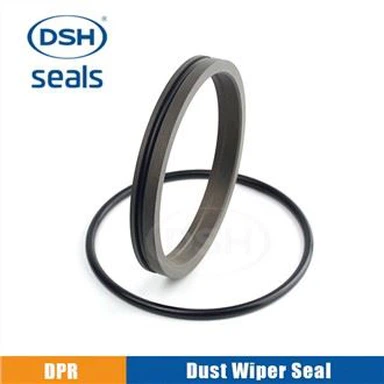Hydraulic Cylinder Seal O-ring Twist Problem
Jun 17, 2022
The twisting of the O-ring in the hydraulic cylinder seal refers to the phenomenon that the O-ring twists in the circumferential direction. The twisting of the O-ring is generally in the dynamic sealing state.
If the O-ring of the hydraulic cylinder seal is properly assembled and used in a working environment with suitable conditions, it is generally not so easy to roll or twist in the reciprocating state because of the contact between the O-ring and the groove. The area is larger than the frictional contact area on the sliding sealing surface, and the resistance of the O-ring itself prevents twisting. The distribution of friction also tends to keep the O-ring stationary in its groove phase, because static friction is greater than sliding friction, and the finish of the groove surface is not as good as that of the sliding seal surface.
There are many reasons for the distortion and damage of the O-ring in the hydraulic cylinder seal, among which the main cause is the uneven gap between the piston, the piston rod and the cylinder barrel, the excessive eccentricity, and the uneven diameter of the O-ring section. , Due to the uneven friction of the O-ring along the circumference, some parts of the O-ring are subject to excessive friction and twist. Usually, the O-ring of the hydraulic cylinder seal with a smaller cross-sectional diameter is prone to uneven friction, resulting in distortion (the O-ring of the dynamic seal hydraulic cylinder seal is larger than the fixed O-ring, which is the reason)
In addition: due to the problem of concentricity deviation of the sealing groove, the uneven sealing height and the uneven diameter of the O-ring section, it may cause a part of the O-ring to be compressed too much, while the other part is too small or not compressed. When the groove is eccentric, that is, the coaxial deviation is greater than the compression amount of the O-ring, the sealing effect will be completely invalid. Another disadvantage of the large deviation of the concentricity of the sealing groove is the uneven compression of the O-ring along the circumference. In addition, there are also factors such as the uneven diameter of the cross-section of the O-ring, the hardness of the material, the thickness of the lubricating oil film, and the surface roughness of the sealing shaft. As a result, a part of the O-ring in the hydraulic cylinder seal slides along the working surface, and the other part rolls, which causes the distortion of the O-ring of the hydraulic cylinder seal. Damage, which is an important cause of damage and leakage of the sealing device.
Therefore, improving the processing of the sealing groove and reducing the eccentricity are important factors to ensure the reliable sealing performance and service life of the O-ring in the hydraulic oil package seal. Install hydraulic cylinder seal O-rings without twisting. If the shape has been twisted during installation, the twisting damage will occur quickly. During work, the twisting phenomenon will cut off the O-ring of the hydraulic cylinder seal, resulting in seal failure and a large amount of oil leakage, and the cut off hydraulic cylinder seal. O-rings will mix into the hydraulic system and cause major accidents.
In order to prevent the twisting damage of the O-ring of the cylinder seal, the following points should be paid attention to in the design:
1) The concentricity of the installation groove of the O-ring of the oil cylinder seal should be considered from two aspects: easy processing and no distortion.
2) The section size of the O-ring of the cylinder seal should be uniform, and the sealing part should be fully coated with lubricating oil or grease during each installation. Sometimes a ring-type refueling device that penetrates the lubricating oil can also be used.
3) Increase the cross-sectional diameter of the O-ring of the oil cylinder seal. The cross-sectional diameter of the O-ring used for the dynamic seal should generally be larger than that of the O-ring used for the static seal; in addition, the O-ring of the oil cylinder seal should avoid using a large-diameter piston seal.
4) When twisting damage occurs under low pressure, a sealing ring can be used to protect the retaining ring.
5) Reduce the surface roughness of cylinder and piston rod.
6) Use materials with low friction coefficient to make O-rings of cylinder seals.
7) The O-ring of the cylinder seal can be replaced by a sealing ring that is not prone to distortion.
a







